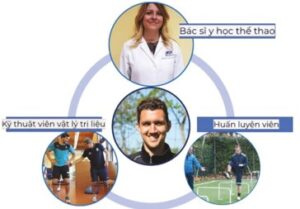1. OVERVIEW
Sports medicine is a dynamic and far-reaching field that has been and continues to expand. It combines many specialties and covers many different medical fields. The medical doctor sport provides comprehensive care to a wide range of patients, including professional athletes, amateurs, and less active populations with musculoskeletal problems that interfere with life activities. daily activity.
Depending on who needs care, the responsibilities of a sports medicine doctor may include the prevention, diagnosis, treatment, and rehabilitation of musculoskeletal conditions including medical conditions that may interfere with performance. participate in physical activity. Forming a sports medicine team is ideal for radically addressing these issues.
The sports medicine physician is responsible for coordinating the multidisciplinary team and will, in many cases, be the primary service provider for the athlete and will be the one to decide when the athlete can return to competition. [1,2].

Everyone who participates in sports is always at risk of injury. Generally, sports injuries can be divided into the following groups of causes:
- Injuries due to overexertion
- Injuries from prison objects
- Fracture and dislocation
- Acute software stretch.
Athletes may need to change incorrect playing techniques that are prone to injury or need adequate time off in conjunction with physical therapy to recover from sports injuries [1].
- SPORTS HEALTH ASSESSMENT
Athletes are often screened for risk assessment before participating in sport. Pre-competition health screening has become a requirement and represents the level of care for athletes in many countries. This requirement appears to have been established due to both medical and legal concerns regarding athletes who may be at greater risk of serious injury or death during competition.
The specific content of this screening has been widely recommended and considered by many authorities in the field of sports health [3,4]. Currently, recommended pre-competition screening includes the collection of history, medical history specific conditions and must complete a physical exertion examination to detect underlying medical conditions in the athlete that could result in injury or death.
The medical history and results of the physical examination will determine the health status and further investigations are required. Since musculoskeletal injuries are a common cause of athlete disqualification, money should be paid. Medical history should attempt to identify all injuries experienced by athletes [5]. In terms of anatomical location, the most common injury that limits the ability to participate in competition is the knee injury, followed by the ankle injury [6]. The strongest independent predictor of sports injury was previous injury [7].
3. CLINICAL SYMPTOMS, DIAGNOSIS
Clinical symptoms are often acute, occurring during sports. Injuries always cause pain, from mild to severe. Signs may be absent or a combination of soft tissue edema, erythema, hot extremities, tenderness, bruising, instability with loss of mobility.
Diagnosis includes history and physical examination. History focused on mechanism of injury, physical exertion, prior trauma, time of onset of pain, duration of muscle pain, and direction of pain before and after exercise. Ask the patient about a history of taking quinolones because they can lead to tendon rupture. Diagnostic testing (eg, imaging X-ray, ultrasound, CT, MRI, electromyography) and referral to a specialist if needed.
4. INITIAL TREATMENT
4.1 PRICE Principle
Immediate treatment of sports injuries using the PRICE principle:
- Protection
- Rest (rest)
- Ice (ice)
- Compression (compression)
- Elevation.
Protection includes rest and where appropriate, motionless (eg, splint) the injured part to prevent further damage.
Rest also prevents further damage and reduces swelling.
Cold compresses vasoconstriction and reduces swelling, inflammation, and soft tissue pain. Ice and cold packs should not be applied directly to the skin. Ice is wrapped with a bag or towel. Ice should be applied several times, each time for no more than 20 minutes. Elastic compression bandages can be wrapped around a sealed plastic bag containing ice to keep it in place [8].
Bandage the injured limb to reduce swelling and pain. Do not wrap the bandage too tightly, it will cause swelling and edema of the extremities.
The site of injury should be elevated above heart level to increase blood circulation by gravity, which, in turn, helps reduce swelling and relieve pain. Ideally, blood should drain from the entire injured organ from high to low to the heart (eg hand and elbow injuries, the hand must be elevated). Apply cold and elevate the injured limb continuously for the first 24 hours after the injury.
4.2. Pain control
Pain control includes the use of pain relievers, usually acetaminophen or an NSAID. NSAIDs are currently recommended in patients with acute pain, with chronic pain requiring further investigation.
COX-1-selective NSAIDs should be avoided in patients with renal impairment or a history of peptic ulcers or inflammation, with COX-2-selective agents potentially increasing cardiovascular risk in patients with pre-existing medical conditions. However, if pain persists more than 72 hours after a minor injury, a specialist should be seen to evaluate for other or more severe injuries. These injuries must be treated properly (eg, immobilization, sometimes oral or injectable corticosteroids).
Corticosteroids should be prescribed by a specialist when necessary because they can slow down soft tissue healing and sometimes weaken tendons and muscles. Injection frequency corticosteroids should be decided by a specialist because excessive injection increases the risk of tissue degeneration, ligament damage or tendon rupture [9].
4.3. Exercise
In general, injured athletes should avoid the activities that caused the injury until they have recovered. To limit muscle atrophy, athletes can practice different exercises, supporting the immobile limb area, and moving the limb without pain. Reduce joint range of motion exercise if it causes the patient to experience unbearable pain. Complete immobilization is usually avoided if the injury is minor.
It is more important to maintain a soft, moderate range of motion for good blood circulation to the injured area to facilitate recovery than to exercise quickly to avoid a decrease in athletic performance. Then practice as much as possible when the pain is relieved. Athletes participating in competition should consult a specialist (eg, physiotherapist, sports coach).
Athletes are trained in an incremental curriculum of exercises and physical therapy to restore flexibility, strength, and endurance. Athletes also need to have a good mentality before participating in the competition. Athletes participating in competition should also receive psychological counseling before and after competition.




